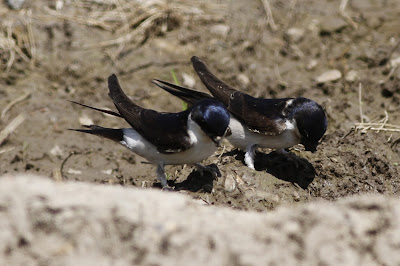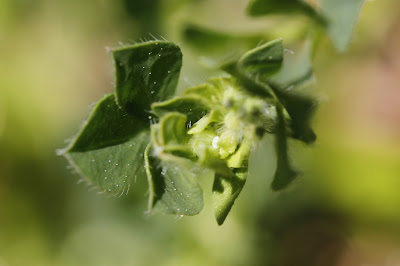A visit up on the Common came up with surprises in the shape of several Brimstone caterpillars of all
sizes , Surprising as I have not seen a single egg laying female , so can only think that they wait till I get to the car before starting . A look in the wooded area where Broad-leaved Helleborine thrive ,
found at least 35 specimens and the final figure should be around the usual 50 when they all show and come into flower . A first for the year was this Mother Shipton day flying moth , reputedly
having the profile of the 'old hag' on it's wings . On the stump of a Scots Pine , I found this orangey/red slime mould . A bit of research followed , and I think it might be Dianema corticatum ,
or not as the case might be . If it is , it will be a first for me . The reader might remember the Pheasant's nest with 11 eggs that I found some time back . All the eggs had gone on a visit , but I was unsure if they had hatched or been predated . With no shells around the nest , I was leaning towards
the latter . On the visit I found a couple of clues to confirm this , the first were two shells that had obviously been predated , then I came across an undamaged one that had been hidden under moss and
roots . Two suspects came to mind , Corvid or Fox . Whichever was the culprit , I'm reasonably sure that the clutch did not hatch .
A visit to the small reserve with feeders started with a stop off at a very quiet Bough Beech
Reservoir , where the only interest was the Common Tern who as usual are nesting on the floating platforms and plastic island on the main reservoir . Moving on , I stopped at the same puddle as I did
last year , and spent an enjoyable half hour watching House Martins and a single Swallow , collecting mud for their nests . My next stop was at a bridge over the River Eden to look for Odonata . Good numbers of Common and Azure Blue and Blue-tailed damselflies and a Downy Emerald perched on the river side of a large Bramble area that looked a certain photographer and camera in the water if any attempt of a shot was tried . The Banded Demoiselles fluttered in the sunshine and a pair
attempted to mate in a more photo-friendly place . With the wind and inexperience , they never did get it together and flew off separated . Only a handful of White-legged Damselflies were found , all
creamy coloured specimens , like this immature male . The bankside vegetation also produced what I can only describe as 'Mission Impossible' . The male Green Dock Beetle / Gastrophysa viridola
attempting to mate with the inflated female . With no food in the feeders , the little reserve was quiet birdwise , but I did hear a Cuckoo calling from the far end , and a single Grass Snake under a tin refugia once again did a 'Usain Bolt' before I could even aim the camera , but a few Four-spotted
Chasers and three Broad-bodied Chasers , kept me occupied , once again risking the camera and a
ducking for the sake of a shot , the one pictured being a female .
The latest butterfly transect at High Elms LNR did nothing to lift the morale , as although reaching the heady heights of 30 butterflies on the two and a half hour transect , 19 of them were Common
Blues , a few of which were females like this one . With 5 Green-veined Whites and 2 Brimstone recorded , four singleton species made up the final total , but at least one of them was an egg laying
Green Hairstreak , and after she moved on , I searched the just opened bud of the Bird's-foot Trefoil
to find a tiny white jewel , smaller than the head of a pin , stuck to the tender young leaves . Again on this visit , orchid numbers increased with 2 more Man Orchids (19) , 6 more Fly Orchids (29) and 5
more Birds-nest Orchids (10) being found . The first flowering Common-spotted Orchid ( pictured ) of the year was also found . On the downside , I found another predated Long-tailed Tit nest whilst on Burnt Gorse . I have also made a couple of visits to Hutchinsons Bank whilst the Glanville Fritillaries are on the wing . They are a short living species and the periods of bad weather
whilst they have been about must have reduced their numbers , but they are still there . I think
Martin's highest count was 39 , but more recently that has dropped to the low teens or single figures . There has been a steady stream of visitors to see this species from all over the country , as it is the only site on the mainland where they can be seen . The Isle of Wight is the only other site for this species in the whole UK . The other star species of the site Small Blue is very slow in putting in an
appearance this year , I have only had a maximum count of 7/8 so far , which is very low indeed . Common Blue females were also found here , one of them flying low and slow looking for the perfect
place to lay her eggs . The spot was chosen , she dropped down and here abdomen extended into the
vegetation . Again I waited for her to move on and then found the two eggs that she had laid . On another visit , I found a Comma , 'form hutchinsoni' , quite apt for the site , with it's golden brown
undersides , compared to the normal dark undersides . The last interest found was the black and white Brassica Shield Bug / Eurydema oleracea , who's spots can be white , red or even yellow , just to
confuse the identification .
15 hours ago


































































